The AMD Trinity Review (A10-4600M): A New Hope
by Jarred Walton on May 15, 2012 12:00 AM ESTAMD Trinity General Performance
Starting as usual with our general performance assessment, we’ve got several Futuremark benchmarks along with Cinebench and x264 HD encoding. The latter two focus specifically on stressing the CPU while PCMarks will cover most areas of system performance (including a large emphasis on storage) and 3DMarks will give us a hint at graphics performance. First up, PCMark 7 and Vantage:
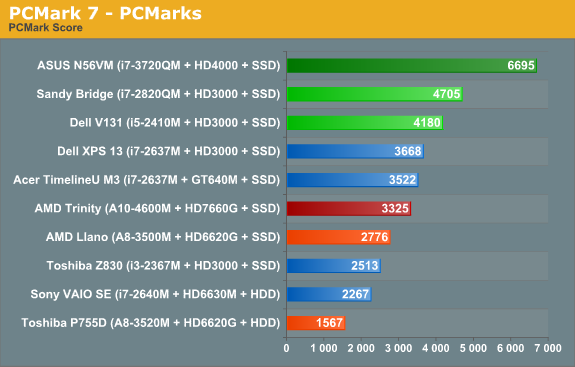
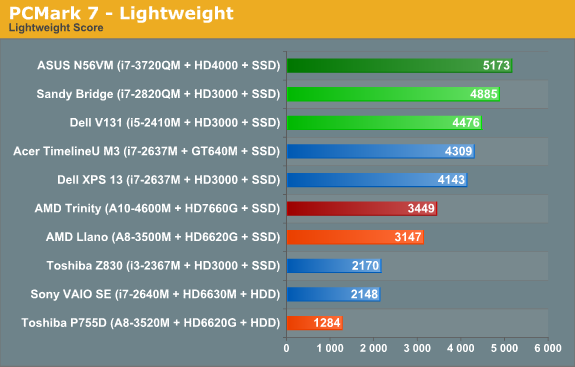
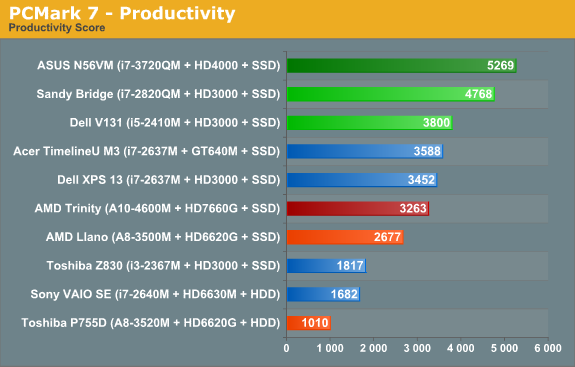

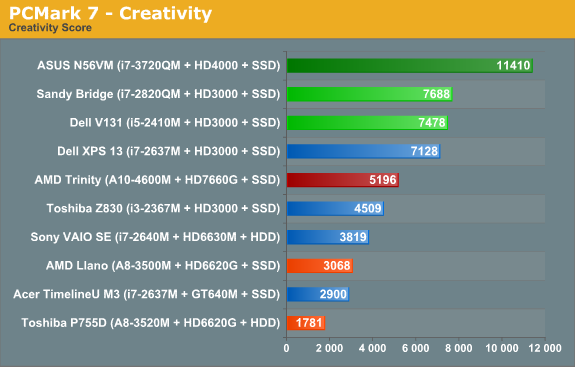
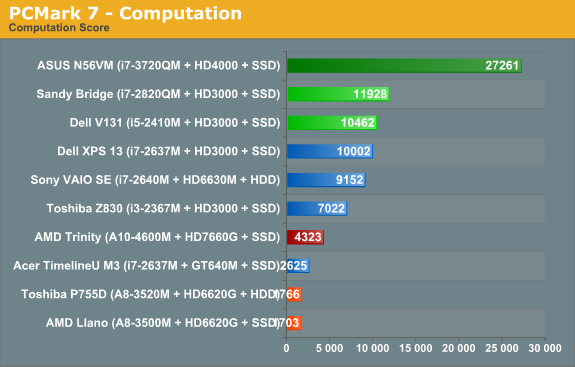
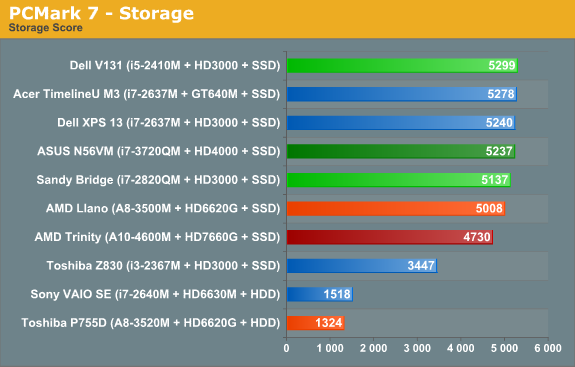
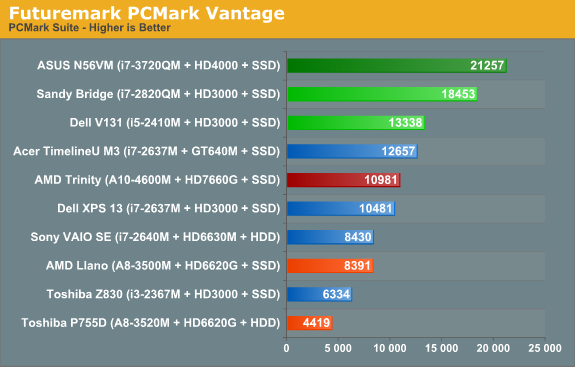
As noted earlier, we ran several other laptops through PCMark 7 and PCMark Vantage testing using the same Intel 520 240GB SSD, plus all the ultrabooks come with SSDs. That removes the SSD as a factor from most of the PCMark comparisons, leaving the rest of the platform to sink or swim on its own. And just how does AMD Trinity do here? Honestly, it’s not too bad, despite positioning within the charts.
Obviously, Intel’s quad-core Ivy Bridge is a beast when it comes to performance, but it’s a 45W beast that costs over $300 just for the CPU. We’ll have to wait for dual-core Ivy Bridge to see exactly how Intel’s latest stacks up against AMD, but if you remember the Llano vs. Sandy Bridge comparisons it looks like we’re in for more of the same. Intel continues to offer superior CPU performance, and even their Sandy Bridge ULV processors can often surpass Llano and Trinity. In the overall PCMark 7 metric, Trinity ends up being 20% faster than a Llano A8-3500M laptop, while Intel’s midrange i5-2410M posts a similar 25% lead on Trinity. Outside of the SSD, we’d expect Trinity and the Vostro V131 to both sell for around $600 as equipped.
A 25% lead for Intel is pretty big, but what you don’t necessarily get from the charts is that for many users, it just doesn’t matter. I know plenty of people using older Core 2 Duo (and even a few Core Duo!) laptops, and for general office tasks and Internet surfing they’re fine. Llano was already faster in general use than Core 2 Duo and Athlon X2 class hardware, and it delivered great battery life. Trinity boosts performance and [spoiler alert!] battery life, so it’s a net win. If you’re looking for a mobile workstation or something to do some hardcore gaming, Trinity won’t cut it—you’d want a quad-core Intel CPU for the former, and something with a discrete GPU for the latter—but for everything else, we’re in the very broad category known as “good enough”.


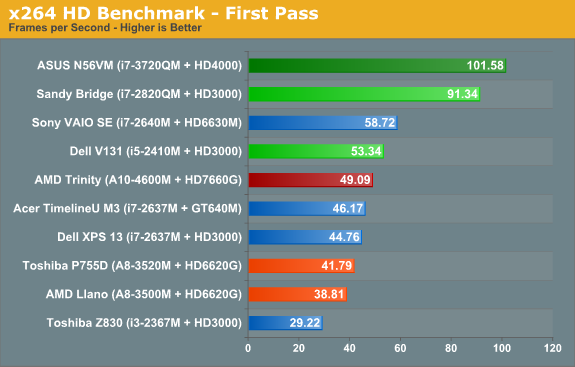
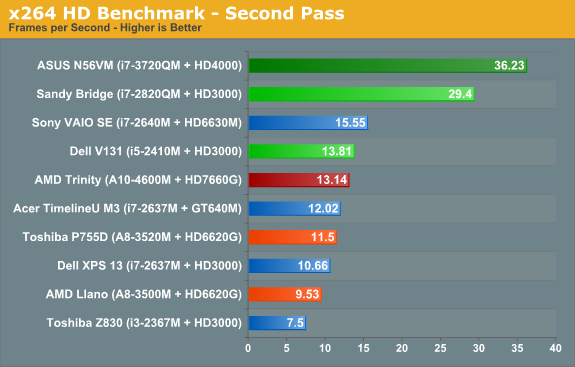
When we start drilling down into other performance metrics, AMD’s CPU performance deficiency becomes pretty obvious. The Cinebench single-threaded score is up 15% from 35W Llano, but in a bit of a surprise the multi-threaded score is basically a wash. Turn to the x264 HD encoding test however and Trinity once again shows a decent 15% improvement over Llano. Against Sandy Bridge and Ivy Bridge, though? AMD’s Trinity doesn’t stand a chance: i5-2410M is 50% faster in single-threaded Cinebench, 27% faster in multi-threaded, and 5-10% faster in x264. It’s a good thing 99.99% of laptop users never actually run applications like Cinebench for “real work”, but if you want to do video encoding a 10% increase can be very noticeable.

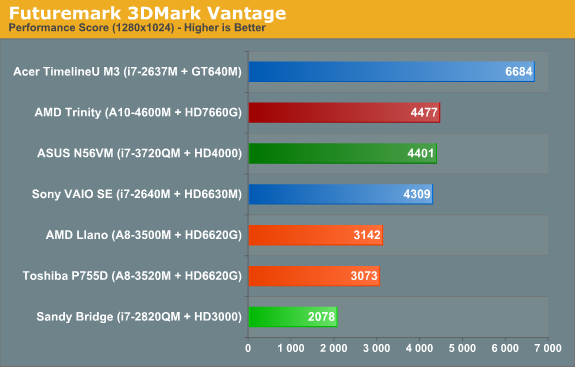
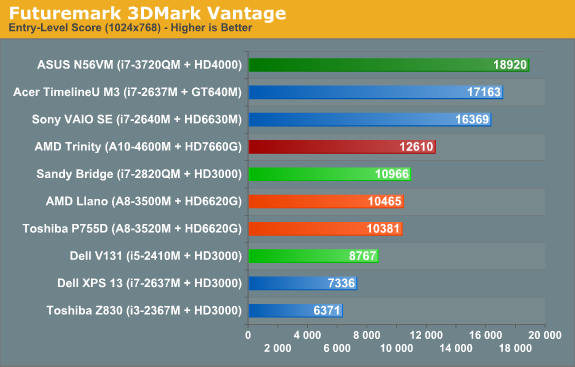
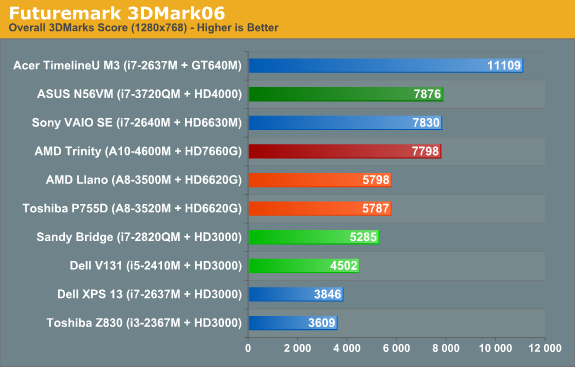
Shift over to graphics oriented benchmarks and the tables turn once again...sort of. Sandy Bridge can’t run 3DMark11, since it only has a DX10 class GPU, but in Vantage Performance and 3DMark06 Trinity is more than twice as fast as HD 3000. Of course, Ivy Bridge’s HD 4000 is the new Intel IGP Sheriff around these parts, and interestingly we see Trinity and i7-3720QM basically tied in these two synthetics. (We’ll just ignore 3DMark Vantage’s Entry benchmark, as it’s so light on graphics quality that we’ve found it doesn’t really stress most GPUs much—even low-end GPUs like HD 3000 score quite well.) We’ll dig into graphics performance more with our gaming benchmarks next.










271 Comments
View All Comments
medi01 - Friday, May 18, 2012 - link
Somehow one doesn't wonder at tomsharware, that comparing chips with vastly different price is a bad idea.TC2 - Sunday, May 20, 2012 - link
amd cpu is far behind intel cpu! about gpu! nvidia is also far better as performance & software support! so for professionals and buyers with budget there isn't point to go with amd! :)))but for amd - as good as is get :))) sorry
kevmanw430 - Tuesday, May 22, 2012 - link
Jarred, what version of Skyrim was tested? Bit of a question in a forum discussion, would like to know.Thanks!
JarredWalton - Wednesday, May 23, 2012 - link
Running the Steam variant, so it's automatically updated. At time of testing, I believe it was version 1.4 (with high res texture pack). The tested sequence is in the area of Whiterun, as I found in initial playing (on a desktop) that it was one of the more demanding areas. I wanted to find the "worst case" situation for playing the game, so that if you get >30 FPS in our benchmark, you'll generally get >30 FPS throughout the game. There's a reasonable chance that other parts of the game are less CPU intensive and thus might show Trinity in a better light, though it's debatable whether that's more or less meaningful than the current results.seapeople - Tuesday, May 22, 2012 - link
Why do you even read computer reviews then? Every single review I've ever read in my life on any site ever created includes a new, top of the line product in the graph REGARDLESS of what's being reviewed. It's not bias, it's not inattentiveness, it's not even remotely absurd as you state, it's quite simply expected for computer reviews.seapeople - Tuesday, May 22, 2012 - link
This is quite silly. We're not comparing a $90,000 Mercedes to a $16,000 Hyundai, we're comparing a processor that might be in an $800 computer to one that might be in a $600 computer based on how sales are at any particular point in time.It's amazing that two or three negative posters account for roughly 50% of the comments on this thread. Somebody is trying too hard.
Stradi - Friday, May 25, 2012 - link
I'm a bit confused about how this review was done. Are they comparing the APU without the extra discrete GPU against intel Ivy Bridge with discrete GPU from nVIDIA and saying the Ivy Bridge is better for gaming? or is this comparing the APU with AMD's discrete GPU that's on crossfire against intel/nVIDIA setup?I assumed the crossfire setup will actually prevail against ivy bridge/nvidia in terms of gaming. I was waiting for Trinity not because it's got a decent GPU in there, but it gives you the option to crossfire with AMD's discrete GPU. And while I like the nVIDIA's discrete GPU option, I didn't think it can havest the intel HD 4000 graphics power and add to it.
I need some clarification on this. I hope they didn't mean to compare an AMD's new APU with Intel's latest+nVIDIA's latest. Why would any reviewer think that'd represent a fair comparison? why would they put an extra discrete GPU in one machine and say that's a better gaming machine?
rarson - Tuesday, May 29, 2012 - link
The AMD APU is not paired with a discrete APU.Obviously the review is confusing and full of incongruous comparisons, but Jarred and Anandtech aren't going to fix it.
rarson - Tuesday, May 29, 2012 - link
Anandtech now responds to criticism by simply deleting it. Or was that Jarred's doing?R3MF - Friday, June 1, 2012 - link
the slides say OpenCL 1.1, will full support in hardware for 1.2 arrive?